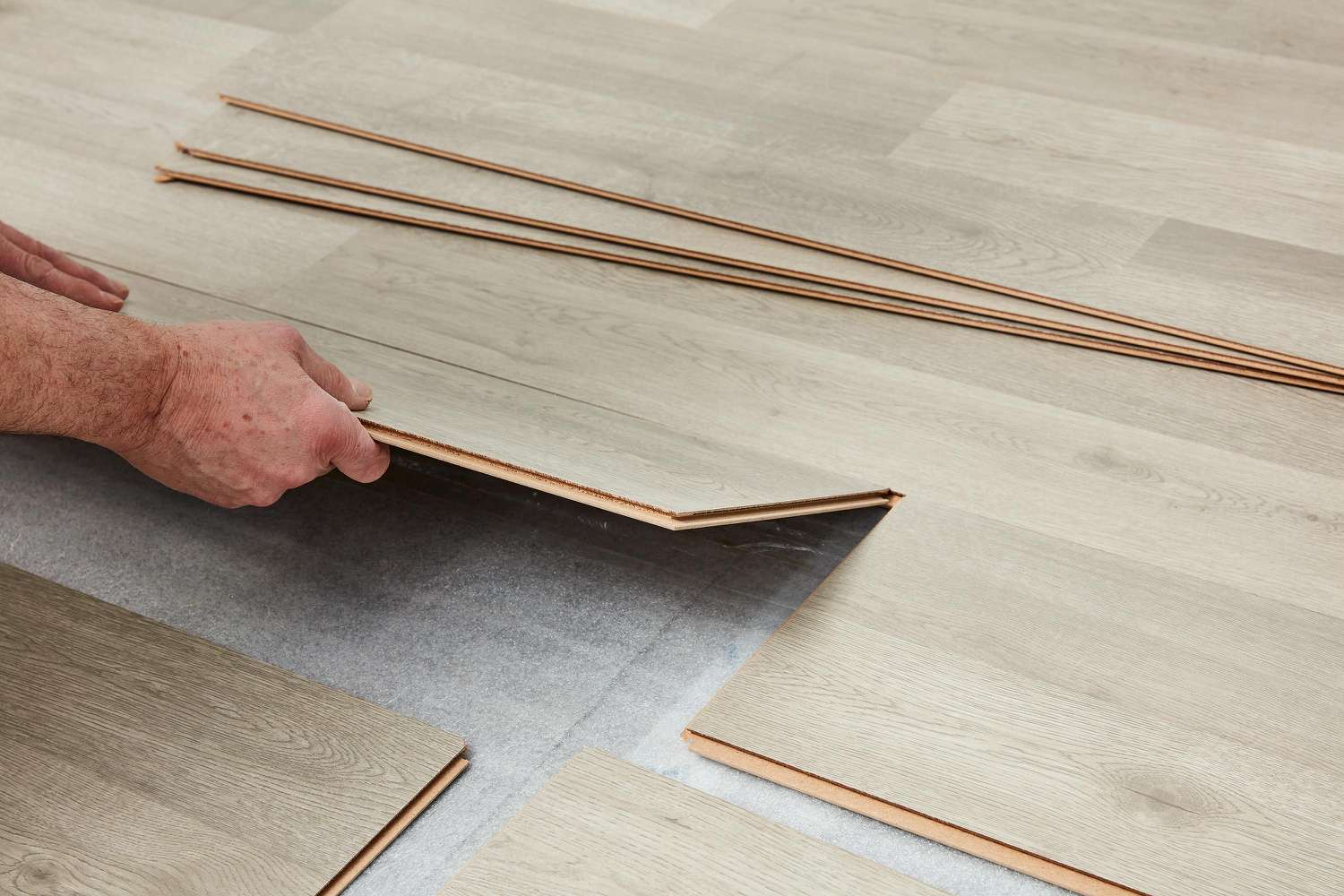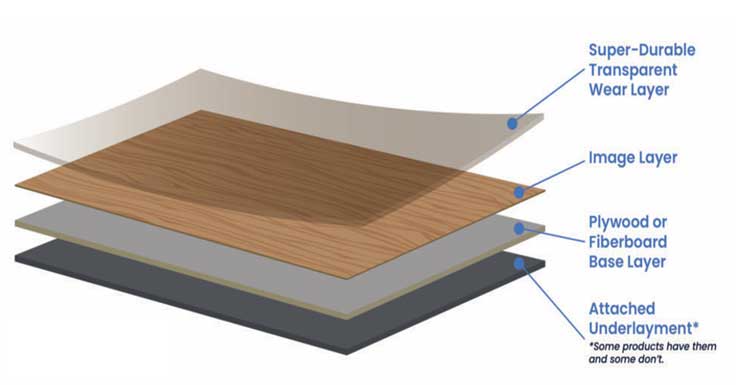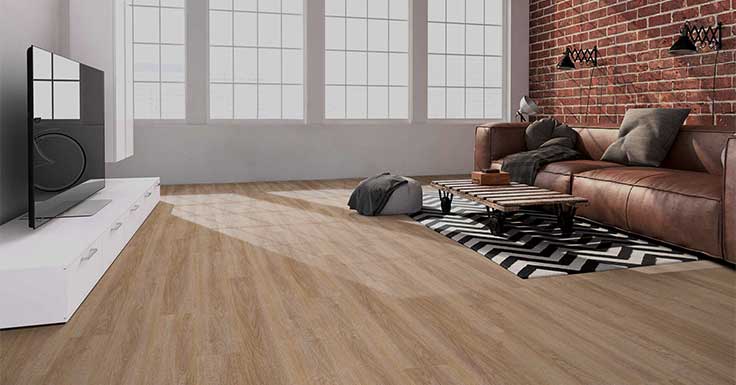Laminate Flooring
Laminate flooring is constructed from thin, pressed wood board with a repeating printed image of wood fused onto a fiberboard core. One thing to note about laminate flooring is that it is not made from plastic but from a collection of wood fibers with a top layer of resin acting as a “wear layer”.
What is laminate flooring, exactly?
It’s a question we hear all the time. Simply put, laminate flooring is a composite flooring material. It’s composed of multiple layers, it’s been around for about 50 years, and it’s designed to add style and value to your home while withstanding wear and tear. Most often, it’s designed to look like wood (but not always).But that’s really just the tip of the iceberg. These days, there are tons of different kinds of laminate flooring—each with its own unique pros and cons. And while it’s often written off due to its comparatively low price point and formerly-artificial appearance (xoxo the 1980s), laminate flooring has really come into its own as a strong, attractive, economical, and low-maintenance type of flooring.
Laminate flooring is incredibly versatile. In addition to the various types of materials, installation methods, surface types and patterns, it also comes in a variety of finishes to achieve the look that you want. It can mimic different types of wood flooring in finishes like oak, walnut, hickory and maple, or it can model tile or stone flooring.


Laminate flooring is composed of three layers:
A dense core or base layer of plywood or high-density fiberboard to give the material strength and stability. This base is the same one used in many of the best engineered wood flooring products.A high-resolution, photo-realistic image layer. Again, this image layer usually mimics wood—but you can find stone-look and even metal-look variants.A protective wear layer to provide hardness and protection. This layer is extremely tough, making laminate one of the most durable flooring options around.Some types of laminate also come with an attached underlayment or backing layer below the base to promote moisture-resistance or add soundproofing qualities, but it depends on the specific product.
What are the types of Laminate Flooring
Types of Laminate Flooring
Plastic:Plastic laminate flooring is completely artificial. It tends to be cheaper approximately half the cost of engineered wood laminate. It’s waterproof and not susceptible to dents, scratches or staining, so it’s excellent for messy and high-traffic areas. Manufacturers have made a lot of progress in making plastic laminate look very close to the material it’s mimicking (whether that’s wood, stone, tile, etc.).Engineered Wood: Engineered Wood flooring uses layers of real wood in addition to the acrylic lamination. This gives it a more wood like appeal and still provides the perks of laminate flooring. Although it can be double the cost of plastic laminate and is also less durable against damage and water. However, unlike plastic laminate, it can be sanded and refinished a few times which can help it last longer.
Surface Types
Smooth: : This is the easiest type of surface to clean, but it can also look less realistic if you want your floor to resemble more natural materials.Textured:Textured or embossed laminate flooring can look more accurate to the materials it’s modeled after. However, the nooks and crannies do make it harder to clean.Distressed:: Distressed or hand scraped laminate flooring is meant to intentionally look old. If you want an antique appearance for a lower cost and higher durability, this is a surface to consider.
Pattern
Traditional: Original laminate flooring was meant to mimic wood flooring so a traditional pattern would follow the standard width and layout of classic wood floors.Thin:Thin planks of laminate flooring can provide a more modern look although it might look less like real wood since narrow wooden plank flooring is not as common.Wide: Laminate flooring in a pattern of wider planks can seem more sturdy and are more reminiscent of older architecture styles.Chevron: A chevron or herringbone pattern offers more dimension and can be a unique feature of the room.

Best Wood-Look Laminate Flooring Options
- 14mm KronoSwiss Origin Wide Plank Laminate.
- 12mm Mannington Arcadia Waterproof Laminate
- 12mm Mohawk Boardwalk Waterproof Laminate
Laminate Flooring – Where to Install?
Laminate is great for hallways, entryways, dining rooms, and living rooms (because its super-durable wear layer means it can stand up to heavy foot traffic and scratches). But its excellent visuals also make it totally suitable for bedrooms, family rooms, and even kitchens in some cases.
Laminate can go anywhere hardwood can
Laminate’s durability is really important to take into account when choosing a floor—especially if you’re comparing the pros and cons of laminate vs. hardwood floors. Laminate can often be the more durable option thanks to its wear layer.That means you can put it just about anywhere you’d be able to put hardwood—especially engineered hardwood. What is engineered hardwood exactly? It’s a multi-layer type of wood flooring that combines a solid wood veneer and a high-performance plywood core. This makes it more rugged and dimensionally stable (which is why you can now buy super wide-plank wood flooring).Engineered wood can go where solid wood can’t—and laminate can too. But if you compare engineered hardwood vs. laminate, you’ll find that laminate is the more durable option.
And it can even go where hardwood can’t
While laminate wasn’t conventionally thought of as a waterproof option, that’s changing—quickly. Products like Mohawk’s RevWood have changed the laminate game by offering completely waterproof productsTranslation: laminate can now go places even water-resistant wood flooring can’t, like busy kitchens and bathrooms!In fact, the only other floors that can compete with waterproof laminate in this arena are waterproof vinyl flooring (although only the very best vinyl plank flooring products can match laminate’s realism) and some different types of tile. But again, only the best wood-look tile can match high-quality laminate’s realistic appearance.It’s all about finding the best floor for the job. If you’re weighing the pros and cons of putting bamboo flooring vs. laminate in your front entryway, you may decide that laminate is the way to go.
Laminate Flooring Benefits
What is laminate flooring’s greatest strength? It’s hard to say—there are a lot of things to love about laminate!
- It’s a great flooring choice for growing families because it’s super durable and easy to maintain.
- There are now of waterproof laminates out there, which means it can be used in some rooms that wood flooring can’t—like kitchens and mudrooms.
- Laminate can duplicate the look of natural floors, and it’s more versatile and moisture-resistant than some other options.
- It’s comfortable to walk on.
- Laminate is super easy to install, and you can do so in a ton of different ways.
- It’s affordable to buy and affordable to install. It’s a fantastic alternative to buying hardwood floors.
- It’s a fantastic alternative to buying hardwood floors.
- Non-toxic laminate flooring is common, as is low-VOC laminate flooring.
Laminate Flooring – Choose the type of Installation
Laminate flooring can be installed in three (3) different types
Glueless Click:: This is the most popular laminate flooring type because it is the easiest to install. It is simple and mess-free. Most laminate flooring in this style uses a double-click method to lock into place completely.Glued: This was the first form of laminate flooring. Applying the glue can be a messy project, but it is also a highly durable installation method when it is placed properly.Pre-Glued:With a simple and mess-free installation process, pre-glued laminate flooring, employs a peel-and-stick method. Sometimes, the pre-applied glue needs to be dampened before the panel is secured to the floor.
Laminate Flooring – Caring and Cleaning
Laminate floors can scratch, so steer clear of anything abrasive (steel wool, for example). You’ll want to use a soft-bristle broom or dust mop to sweep up debris. If you’re vacuuming, be careful to use an attachment without a beater bar or rotating brush, which could scratch the surface.A very effective strategy of cleaning your laminate floors is to use warm water with a tablespoon of vinegar. Vinegar is a natural cleaner and will help remove any buildup of dirt and stains without damaging the laminate.Use a gentle cleanser to spot-clean visibly dirty areas, and always follow up by wiping the area with a dry, absorbent cloth. One simple cleaner that works well with laminate is: 1 part rubbing alcohol + 3 parts water + a squirt of dish soap, applied using a lightly dampened cloth.
Ways to Bring Back the Shine to Your Laminate Floors
Sweep and vacuum the floors. Use a microfiber mop or a soft broom to sweep the debris out of the room. This will help get rid of the dirt particles that are easier to remove from your floor. To get rid of more stubborn particles, use a vacuum cleaner with a hard floor attachment, similar to those used for wood floors. Avoid using other attachments and vacuums with a beater bar, as these can scratch your flooring and leave permanent marks.Prepare a laminate-formulated floor cleaner. . Use cleaners that are specially formulated for laminate floors. Avoid using soap-based and oil-based cleaners, as this can cause your floors to warp over time. If you can’t find any laminate cleaners in your area, you can make your own laminate flooring cleaner using a water solution by mixing equal parts of water, white vinegar, and rubbing alcohol in a spray bottle. Mix the spray bottle until all three are fully combined.Spray a thin layer onto your floor.A few spritzes can go a long way, especially for laminate flooring. Laminate flooring does not react well to water, so it’s best to spray in sections rather than spraying the entire floor at once.Mop the floor. Use your mop to wipe the cleaner in the direction of the grain. You’ll want your floors to be damp from the cleaner, but not too wet. Once one section is finished, spray your cleaner onto the next section of the room and repeat the process until the entire floor is mopped.Air-dry the room.Let the cleaner dry up. Open the room’s doors and windows to ensure sufficient air circulation. You’ll want to give it up to 30 minutes to completely dry. Avoid letting anyone into the room during this time, as their steps can add dirt back onto the floor and diminish its shine.Buff any additional dull spots.Once the floor dries, it should restore its shine. If there are parts that still look dull, use a dry microfiber cloth to buff out spots until it shines.
